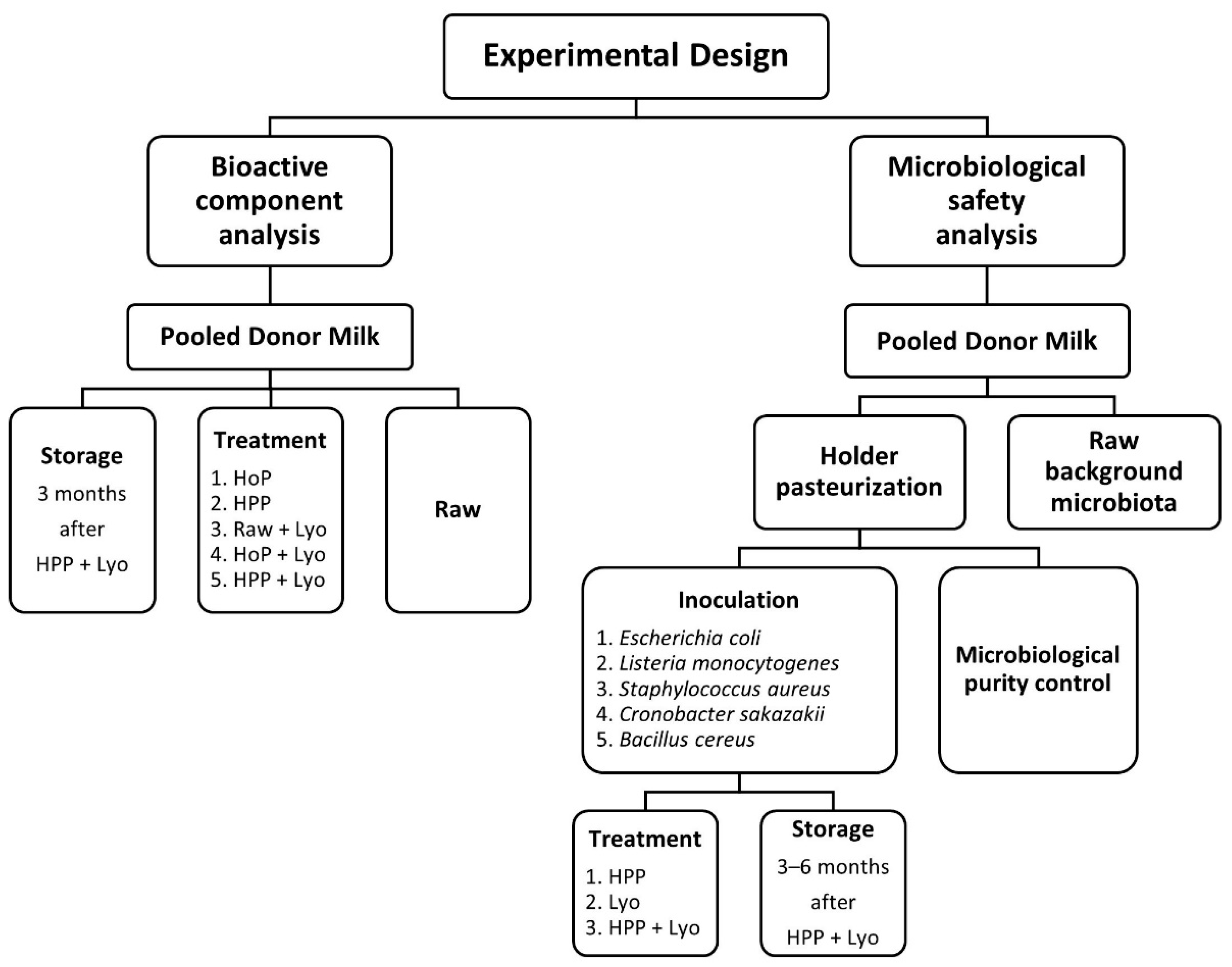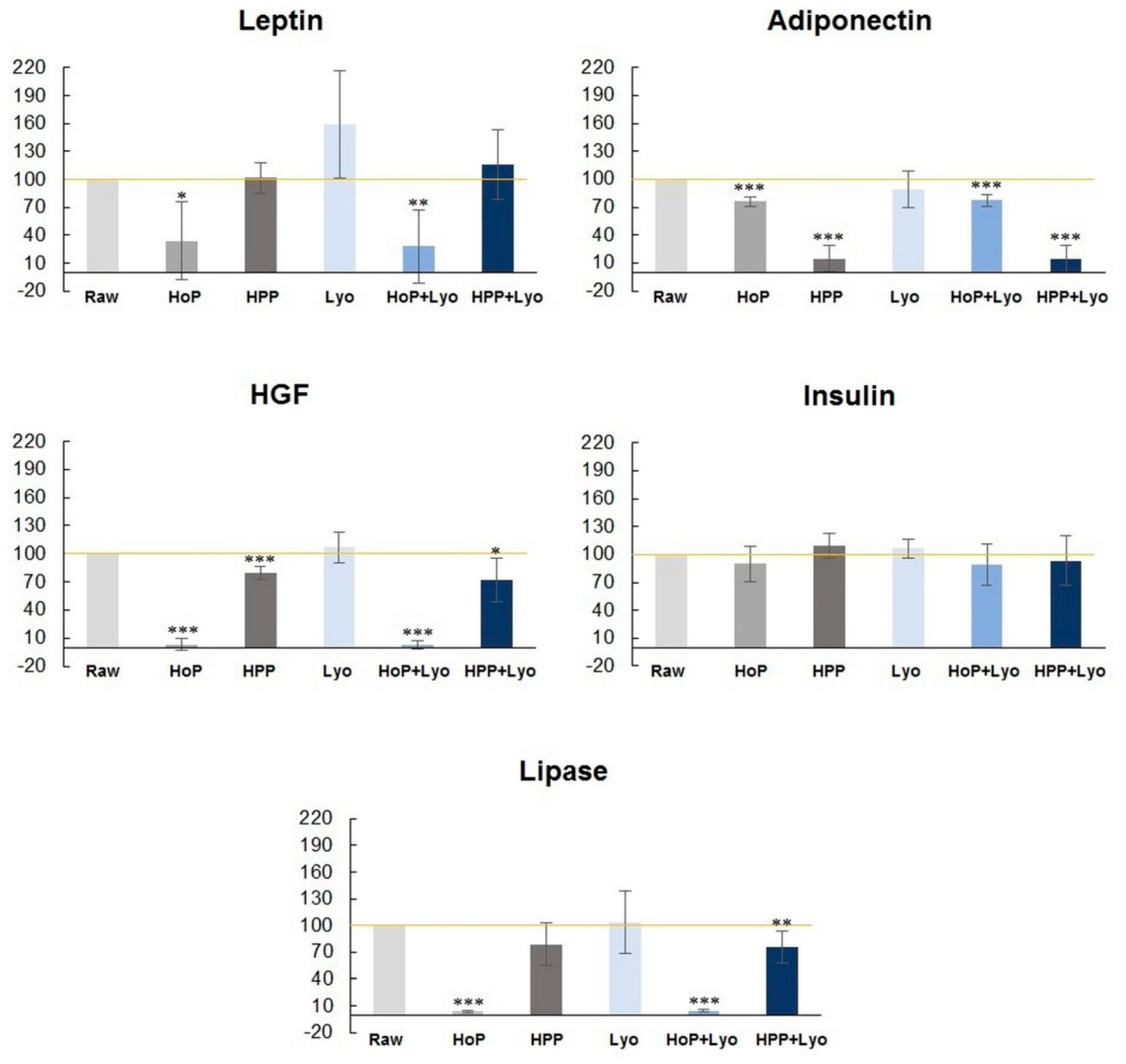Combination of High-Pressure Processing and Freeze-Drying as the Most Effective Techniques in Maintaining Biological Values and Microbiological Safety of Donor Milk
Abstract
1. Introduction
2. Materials and Methods
2.1. Experimental Design and Sample Preparation
2.2. Determination of Bioactive Components
- (a)
- raw, untreated milk (Raw),
- (b)
- holder pasteurization (HoP),
- (c)
- high-pressure processing (HPP) (450 MPa, 21 °C, 15 min),
- (d)
- freeze-drying (Lyo) (Raw + Lyo),
- (e)
- holder pasteurization followed by freeze-drying (HoP + Lyo),
- (f)
- high-pressure processing followed by freeze-drying (HPP + Lyo).
2.3. Holder Pasteurization
2.4. High-Pressure Processing
2.5. Freeze-Drying
2.6. Microbiological Safety Assessment
2.7. Statistical Analysis
3. Results
3.1. Determination of Bioactive Components in Treatment Milk Samples
3.2. Microbiological Safety
3.2.1. Native Microbiota
3.2.2. Microbiological Purity after High-Pressure Processing and Freeze-Drying in Storage Milk Samples
4. Discussion
5. Conclusions
Author Contributions
Funding
Institutional Review Board Statement
Informed Consent Statement
Data Availability Statement
Acknowledgments
Conflicts of Interest
References
- Ballard, O.; Morrow, A.L. Human milk composition: Nutrients and bioactive factors. Pediatr. Clin. N. Am. 2013, 60, 49–74. [Google Scholar] [CrossRef] [PubMed]
- Pedriatrics, A.A.O. Breastfeeding and the Use of Human Milk. Pediatrics 2012, 129, e827–e841. [Google Scholar] [CrossRef]
- WHO. Guidelines on Optimal Feeding of Low Birth-Weight Infants in Low- and Middle-Income Countries; WHO: Geneva, Switzerland, 2011. [Google Scholar]
- Haiden, N.; Ziegler, E.E. Human Milk Banking. Ann. Nutr. Metab. 2016, 69 (Suppl. 2), 8–15. [Google Scholar] [CrossRef]
- Kantorowska, A.; Wei, J.C.; Cohen, R.S.; Lawrence, R.A.; Gould, J.B.; Lee, H.C. Impact of Donor Milk Availability on Breast Milk Use and Necrotizing Enterocolitis Rates. Pediatrics 2016, 137, e20153123. [Google Scholar] [CrossRef]
- Moro, G.E.; Billeaud, C.; Rachel, B.; Calvo, J.; Cavallarin, L.; Christen, L.; Escuder-Vieco, D.; Gaya, A.; Lembo, D.; Wesolowska, A.; et al. Processing of Donor Human Milk: Update and Recommendations From the European Milk Bank Association (EMBA). Front. Pediatr. 2019, 7, 49. [Google Scholar] [CrossRef]
- Weaver, G.; Bertino, E.; Gebauer, C.; Grovslien, A.; Mileusnic-Milenovic, R.; Arslanoglu, S.; Barnett, D.; Boquien, C.Y.; Buffin, R.; Gaya, A.; et al. Recommendations for the Establishment and Operation of Human Milk Banks in Europe: A Consensus Statement From the European Milk Bank Association (EMBA). Front. Pediatr. 2019, 7, 53. [Google Scholar] [CrossRef] [PubMed]
- Hanson, M.L.; Wendorff, W.L.; Houck, K.B. Effect of heat treatment of milk on activation of Bacillus spores. J. Food Prot. 2005, 68, 1484–1486. [Google Scholar] [CrossRef]
- Lewin, A.; Delage, G.; Bernier, F.; Germain, M. Banked Human Milk and Quantitative Risk Assessment of Bacillus cereus Infection in Premature Infants: A Simulation Study. Can. J. Infect. Dis. Med. Microbiol. 2019, 2019, 6348281. [Google Scholar] [CrossRef] [PubMed]
- Lewin, A.; Quach, C.; Rigourd, V.; Picaud, J.C.; Perreault, T.; Frange, P.; Domingo, M.C.; Lalancette, C.; Delage, G.; Germain, M. Bacillus cereus infection in neonates and the absence of evidence for the role of banked human milk: Case reports and literature review. Infect. Control. Hosp. Epidemiol. 2019, 40, 787–793. [Google Scholar] [CrossRef] [PubMed]
- Peila, C.; Moro, G.E.; Bertino, E.; Cavallarin, L.; Giribaldi, M.; Giuliani, F.; Cresi, F.; Coscia, A. The Effect of Holder Pasteurization on Nutrients and Biologically-Active Components in Donor Human Milk: A Review. Nutrients 2016, 8, 477. [Google Scholar] [CrossRef]
- Guerra, A.F.; Mellinger-Silva, C.; Rosenthal, A.; Luchese, R.H. Hot topic: Holder pasteurization of human milk affects some bioactive proteins. J. Dairy Sci. 2018, 101, 2814–2818. [Google Scholar] [CrossRef]
- Alexandre, E.M.C.; Pinto, C.A.; Moreira, S.A.; Pintado, M.; Saraiva, J.A. 5—Nonthermal food processing/preservation technologies. In Saving Food; Galanakis, C.M., Ed.; Academic Press: Cambridge, MA, USA, 2019; pp. 141–169. [Google Scholar] [CrossRef]
- Silva, F.V.M.; Gibbs, P.A. Thermal pasteurization requirements for the inactivation of Salmonella in foods. Food Res. Int. 2012, 45, 695–699. [Google Scholar] [CrossRef]
- Huang, H.-W.; Wu, S.-J.; Lu, J.-K.; Shyu, Y.-T.; Wang, C.-Y. Current status and future trends of high-pressure processing in food industry. Food Control. 2017, 72, 1–8. [Google Scholar] [CrossRef]
- Sousa, S.G.; Delgadillo, I.; Saraiva, J.A. Human Milk Composition and Preservation: Evaluation of High-pressure Processing as a Nonthermal Pasteurization Technology. Crit. Rev. Food Sci. Nutr. 2016, 56, 1043–1060. [Google Scholar] [CrossRef] [PubMed]
- Wesolowska, A.; Sinkiewicz-Darol, E.; Barbarska, O.; Bernatowicz-Lojko, U.; Borszewska-Kornacka, M.K.; van Goudoever, J.B. Innovative Techniques of Processing Human Milk to Preserve Key Components. Nutrients 2019, 11, 1169. [Google Scholar] [CrossRef]
- Wesolowska, A.; Sinkiewicz-Darol, E.; Barbarska, O.; Strom, K.; Rutkowska, M.; Karzel, K.; Rosiak, E.; Oledzka, G.; Orczyk-Pawilowicz, M.; Rzoska, S.; et al. New Achievements in High-Pressure Processing to Preserve Human Milk Bioactivity. Front. Pediatr. 2018, 6, 323. [Google Scholar] [CrossRef] [PubMed]
- Demazeau, G.; Plumecocq, A.; Lehours, P.; Martin, P.; Couedelo, L.; Billeaud, C. A New High Hydrostatic Pressure Process to Assure the Microbial Safety of Human Milk While Preserving the Biological Activity of Its Main Components. Front. Public Health 2018, 6, 306. [Google Scholar] [CrossRef]
- Lenati, R.F.; O’Connor, D.L.; Hebert, K.C.; Farber, J.M.; Pagotto, F.J. Growth and survival of Enterobacter sakazakii in human breast milk with and without fortifiers as compared to powdered infant formula. Int. J. Food Microbiol. 2008, 122, 171–179. [Google Scholar] [CrossRef]
- Salcedo, J.; Gormaz, M.; Lopez-Mendoza, M.C.; Nogarotto, E.; Silvestre, D. Human milk bactericidal properties: Effect of lyophilization and relation to maternal factors and milk components. J. Pediatr. Gastroenterol. Nutr. 2015, 60, 527–532. [Google Scholar] [CrossRef]
- Castro Albarran, J.; Navarro Hernandez, R.E.; Solis Pacheco, J.R.; Salazar Quinones, I.C.; Macias Lopez, G.G.; Barrera de Leon, J.C.; Aguilar Uscanga, B.R. Impact of pasteurization/freeze-drying on available immunoglobulin content of the mature human milk. Use in human milk banking of hospitals. Nutr. Hosp. 2017, 34, 899–906. [Google Scholar] [CrossRef]
- Lozano, B.; Castellote, A.I.; Montes, R.; López-Sabater, M.C. Vitamins, fatty acids, and antioxidant capacity stability during storage of freeze-dried human milk. Int. J. Food Sci. Nutr. 2014, 65, 703–707. [Google Scholar] [CrossRef] [PubMed]
- Martysiak-Żurowska, D.; Rożek, P.; Puta, M. The effect of freeze-drying and storage on lysozyme activity, lactoferrin content, superoxide dismutase activity, total antioxidant capacity and fatty acid profile of freeze-dried human milk. Dry. Technol. 2020, 1–11. [Google Scholar] [CrossRef]
- Bomfim, V.S.; Jordao, A.A.J.; Alves, L.G.; Martinez, F.E.; Camelo, J.S., Jr. Human milk enriched with human milk lyophilisate for feeding very low birth weight preterm infants: A preclinical experimental study focusing on fatty acid profile. PLoS ONE 2018, 13, e0202794. [Google Scholar] [CrossRef]
- Oliveira, M.M.; Aragon, D.C.; Bomfim, V.S.; Trevilato, T.M.B.; Alves, L.G.; Heck, A.R.; Martinez, F.E.; Camelo, J.S., Jr. Development of a human milk concentrate with human milk lyophilizate for feeding very low birth weight preterm infants: A preclinical experimental study. PLoS ONE 2019, 14, e0210999. [Google Scholar] [CrossRef]
- Fernandez, L.; Langa, S.; Martin, V.; Jimenez, E.; Martin, R.; Rodriguez, J.M. The microbiota of human milk in healthy women. Cell Mol. Biol. (Noisy-le-Grand) 2013, 59, 31–42. [Google Scholar]
- Bowen, A.; Wiesenfeld, H.C.; Kloesz, J.L.; Pasculle, A.W.; Nowalk, A.J.; Brink, L.; Elliot, E.; Martin, H.; Tarr, C.L. Notes from the Field: Cronobacter sakazakii Infection Associated with Feeding Extrinsically Contaminated Expressed Human Milk to a Premature Infant—Pennsylvania, 2016. MMWR Morb. Mortal Wkly. Rep. 2017, 66, 761–762. [Google Scholar] [CrossRef]
- Adjide, C.C.; Leke, A.; Mullie, C. Bacillus cereus contamination of pasteurized human milk donations: Frequency, origin, seasonal distribution, molecular typing of strains and proposed corrective/preventive actions. J. Matern. Fetal Neonatal Med. 2020, 1–8. [Google Scholar] [CrossRef]
- Silvestre, D.; Ruiz, P.; Martinez-Costa, C.; Plaza, A.; Lopez, M.C. Effect of pasteurization on the bactericidal capacity of human milk. J. Hum. Lact. 2008, 24, 371–376. [Google Scholar] [CrossRef] [PubMed]
- Terpstra, F.G.; Rechtman, D.J.; Lee, M.L.; Hoeij, K.V.; Berg, H.; Van Engelenberg, F.A.; Van’t Wout, A.B. Antimicrobial and antiviral effect of high-temperature short-time (HTST) pasteurization applied to human milk. Breastfeed. Med. 2007, 2, 27–33. [Google Scholar] [CrossRef] [PubMed]
- Christen, L.; Lai, C.T.; Hartmann, B.; Hartmann, P.E.; Geddes, D.T. The effect of UV-C pasteurization on bacteriostatic properties and immunological proteins of donor human milk. PLoS ONE 2013, 8, e85867. [Google Scholar] [CrossRef] [PubMed]
- Archacka, M.; Bialas, W.; Dembczynski, R.; Olejnik, A.; Sip, A.; Szymanowska, D.; Celinska, E.; Jankowski, T.; Olejnik, A.; Rogodzinska, M. Method of preservation and type of protective agent strongly influence probiotic properties of Lactococcus lactis: A complete process of probiotic preparation manufacture and use. Food Chem. 2019, 274, 733–742. [Google Scholar] [CrossRef]
- Wesolowska, A.; Brys, J.; Barbarska, O.; Strom, K.; Szymanska-Majchrzak, J.; Karzel, K.; Pawlikowska, E.; Zielinska, M.A.; Hamulka, J.; Oledzka, G. Lipid Profile, Lipase Bioactivity, and Lipophilic Antioxidant Content in High Pressure Processed Donor Human Milk. Nutrients 2019, 11, 1972. [Google Scholar] [CrossRef]
- Viazis, S.; Farkas, B.E.; Jaykus, L.A. Inactivation of bacterial pathogens in human milk by high-pressure processing. J. Food Prot. 2008, 71, 109–118. [Google Scholar] [CrossRef]
- Permanyer, M.; Castellote, C.; Ramirez-Santana, C.; Audi, C.; Perez-Cano, F.J.; Castell, M.; Lopez-Sabater, M.C.; Franch, A. Maintenance of breast milk Immunoglobulin A after high-pressure processing. J. Dairy Sci. 2010, 93, 877–883. [Google Scholar] [CrossRef] [PubMed]
- Shenker, N.; Virtual Collaborative Network of Human Milk Banks and Associations. Maintaining safety and service provision in human milk banking: A call to action in response to the COVID-19 pandemic. Lancet Child. Adolesc. Health 2020, 4, 484–485. [Google Scholar] [CrossRef]
- Moro, G.E.; Bertino, E. Breastfeeding, Human Milk Collection and Containers, and Human Milk Banking: Hot Topics During the COVID-19 Pandemic. J. Hum. Lact. 2020, 890334420934391. [Google Scholar] [CrossRef]
- Marinelli, K.A. International Perspectives Concerning Donor Milk Banking During the SARS-CoV-2 (COVID-19) Pandemic. J. Hum. Lact. 2020. [Google Scholar] [CrossRef] [PubMed]




| Genus | IC 1 | HPP | HPP + Lyo 0 | HPP + Lyo 3 | HPP + Lyo 6 | IE 2 | %RG 3 |
|---|---|---|---|---|---|---|---|
| Staphylococcus aureus | 6.83 ± 0.03 | 0 | 0 | 0 | 0 | 6.83 | 100% |
| Escherichia coli | 7.07 ± 0.13 | 0 | 0 | 0 | 0 | 7.07 | 100% |
| Listeria monocytogenes | 7.91 ± 0.04 | 0 | 0 | 0 | 0 | 7.91 | 100% |
| Bacillus cereus | 5.3 ± 0.08 | 0 | 0 | 0 | 0 | 5.3 | 100% |
| Cronobacter sakazakii | 5.9 ± 0.24 | 0 | 0 | 0 | 0 | 5.9 | 100% |
Publisher’s Note: MDPI stays neutral with regard to jurisdictional claims in published maps and institutional affiliations. |
© 2021 by the authors. Licensee MDPI, Basel, Switzerland. This article is an open access article distributed under the terms and conditions of the Creative Commons Attribution (CC BY) license (http://creativecommons.org/licenses/by/4.0/).
Share and Cite
Jarzynka, S.; Strom, K.; Barbarska, O.; Pawlikowska, E.; Minkiewicz-Zochniak, A.; Rosiak, E.; Oledzka, G.; Wesolowska, A. Combination of High-Pressure Processing and Freeze-Drying as the Most Effective Techniques in Maintaining Biological Values and Microbiological Safety of Donor Milk. Int. J. Environ. Res. Public Health 2021, 18, 2147. https://doi.org/10.3390/ijerph18042147
Jarzynka S, Strom K, Barbarska O, Pawlikowska E, Minkiewicz-Zochniak A, Rosiak E, Oledzka G, Wesolowska A. Combination of High-Pressure Processing and Freeze-Drying as the Most Effective Techniques in Maintaining Biological Values and Microbiological Safety of Donor Milk. International Journal of Environmental Research and Public Health. 2021; 18(4):2147. https://doi.org/10.3390/ijerph18042147
Chicago/Turabian StyleJarzynka, Sylwia, Kamila Strom, Olga Barbarska, Emilia Pawlikowska, Anna Minkiewicz-Zochniak, Elzbieta Rosiak, Gabriela Oledzka, and Aleksandra Wesolowska. 2021. "Combination of High-Pressure Processing and Freeze-Drying as the Most Effective Techniques in Maintaining Biological Values and Microbiological Safety of Donor Milk" International Journal of Environmental Research and Public Health 18, no. 4: 2147. https://doi.org/10.3390/ijerph18042147
APA StyleJarzynka, S., Strom, K., Barbarska, O., Pawlikowska, E., Minkiewicz-Zochniak, A., Rosiak, E., Oledzka, G., & Wesolowska, A. (2021). Combination of High-Pressure Processing and Freeze-Drying as the Most Effective Techniques in Maintaining Biological Values and Microbiological Safety of Donor Milk. International Journal of Environmental Research and Public Health, 18(4), 2147. https://doi.org/10.3390/ijerph18042147








